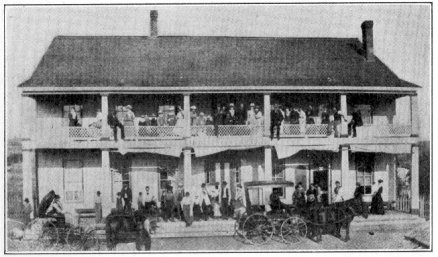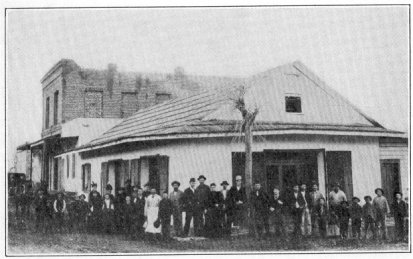
[click to enlarge]
Hornitos Hotel, ready to receive an ex-President.
| Online Library: | Title | Author | California | Geology | History | Indians | Muir | Mountaineering | Nature | Management |
Yosemite > Library > Call of Gold > 32. Angevine Reynolds and His Writings >
Next: 33. Coulterville • Contents • Previous: 31. John Hite
One of the Mariposa forty-niners who stayed and became an outstanding citizen, was Angevine Reynolds. He was born December 9, 1829, and passed away December 17, 1888. [Editor’s note: November 17, 1888 according to the Mariposa Gazette—dea] When a few months under twenty years of age, he arrived on Mariposa Creek. He followed mining until 1851 and then became connected with a stage and express business which necessitated his residing in Stockton, a good part of the time, for four years. At the end of that time, he returned to Mariposa, where he resided until his death.
For a time, he was associated with J. O. Lovejoy in a saw-mill enterprise. Later, he was Deputy County Clerk and then County Clerk for fourteen years. In 1874, he purchased the Gazette and in 1876, he was admitted to the bar.
He proved himself to be one of the Gazette’s best editors, although much of the credit for his success in this line, is due to his second wife. He was peculiarly fitted to succeed in the California of early days with its heterogeneous, but intelligent, population. According to his daughter, whom the author interviewed, he never had a day’s schooling in his life. His education was all acquired by experience and home study. He could swear like a trooper; “Damn it, old Abe,” he would say to his old horse, “I ain’t swearing.”
As examples of Reynold’s expressive ability and for their historical value, the author is reproducing herewith four of his newspaper articles:
-1-
“Were the old Mariposa mine a living thing of flesh and blood, with human knowledge and speech, it could reveal a chapter of facts, that would excite the wonder of men, almost as much as would the Arabian Night entertainment, if their highly burnished stories were truth instead of fiction. No quartz lode ever struck on the Pacific Slope has proven so rich in what are termed ‘pockets’ and none have yielded more of glittering gold that never found its way to the iron safes of its owners, than has this identical mine, which forms the southern boundary of the town of Mariposa. The information upon which this opinion is based has been derived from men employed in this mine, some of whom still reside here and may be relied on as correct.
“After Olmstead on the Mariposa Estate, came the Dodge brothers merchants of San Francisco, who were creditors of said Estate to an amount considerably less than $100,000. They took charge of the Estate, mills and mines, which at that time were in good working condition. Their administration continued about a year, during which time, the mine was worked in such a manner as to make it pay at once, without regard to its further working, or in the interest of the Estate. The pillars, rich with gold, that supported the mine, were blasted and cut away, and the proceeds dodged into the pockets of these avaricious creditors, who seemed to have it all their own way, there being no receiver except themselves. Upon closing their affairs with the Estate, they even tore up the copper plates of the mill; pipes and anything of value were shipped off to San Francisco and sold. Without going into further detail, it can safely be estimated that it cost the Estate a half million dollars to pay the debt of Dodge brothers, which did not exceed $80,000.
“We have resided here continuously ever since the first discovery of this vein and assert what all the old citizens know, that all the work put upon it has been ill-directed by those who had no competent knowledge of mining; that mismanagement marked the course of all those who have had charge of it; that thousands upon thousands of dollars were purloined by the laborers employed; yet, notwithstanding all this, it has yielded millions.”
-2-
“If anyone, in this month of May, 1876, desires to look upon and enjoy a beautiful rural retreat, such as poets love to describe

[click to enlarge] Hornitos Hotel, ready to receive an ex-President. |

[click to enlarge] Reeb’s butcher shop, at corner of Plaza, Hornitos. |
“There, Captain Thomas and Richard, his brother, have lived ever since Mariposa was first a cluster of miner’s tenements. The Captain and his brother are from Maryland and are ranked among our most worthy and intelligent citizens.
“Their house, unpretentious, with a gallery full length in front, is shaded by trees, and a stream from Stockton Creek ripples through the yard.
“On entering the house, are seen two life-sized likenesses, one to the right and one to the left of the mantle-piece, of those two incomparable Confederate Generals, Robert E. Lee and Stonewall Jackson. The frames were made from part of a limb from one of the Big Trees, the ‘Andrew Johnson’, which was so-named by ex-Vice President Colfax, when he visited the Mariposa Grove, because ‘it leaned to the south’. There is also a picture of Mariposa, by A. Schwartz, a sort of natural genius, who used to live here and then enlisted in the Federal army under Siegel.
“Our mind wandered back to the old town, with its streets, hotels and business houses, swarming with life, and we again in thought enjoyed the companionship of former citizens. Genial Josh Crippen, Sam Merritt, afterwards Chief Justice of Utah, Judge Daley, Judge Bondurant, Bell, Washburn, Postmaster McNamara, J. A. Henry, Kraft and son, Lui Knoble, Mello, who kept the Franklin house, McVicar, Gregory and Miller, who kept the old Southern Hotel, Blumenthal, Torney, Newcomb, Van Dyke and Vining, who kept saloons, Cashman and Sullivan, P. Hussey & Co., McDermott & Co., J. A. Grandvoinette and many others, who were merchandisers, all arose fresh in our mind.
“From the hall room, we entered another large room, with a small library of well-chosen books, histories, biographies, poetry, encyclopedia, etc. The cabinet contained many curiosities, every variety of quartz specimens and other minerals. There was also a revolving apparatus depicting Yosemite scenes, a section of the first Atlantic cable, and also, over the entrance, there was the largest pair of elk antlers ever found in the State.”
-3-
“With this issue of the Gazette, June 11, 1881, closes the twenty-sixth volume. After Holmes’ death in 1862, he was succeeded in proprietorship by Mr. A. M. Swaney, who conducted the Gazette with marked ability during his administration, which included the fratricidal war between the North and South. Taking sides with the Union, he maintained that position firmly and fearlessly.
Following Swaney were the Harris brothers, John and Thomas, two men who had acquired the art of printing and were able to conduct the mechanical department of the paper within themselves. Following the Harris brothers, came Mr. James H. Lawrence, well-known as a journalist in this section for many years. Sometime during 1873, he became proprietor of the Gazette, the paper which had withstood the varied elements of fire and politics and which has lived to chronicle almost numberless exits from this mortal sphere and of the gradual changes that have taken place from year to year, both in the County and State and in the world over.
“In looking over several numbers of 1854, we see names of several distinguished persons who have since passed away. Among them, we notice more particularly those of Hon. J. M. Bondurant, County Judge and Judge of the Court of Sessions, with Alfred F. Washburn and Lewis Sharp as Associate Justices and who have long since passed away.
“The Gazette has been under our control and management since January 1, 1875, during which time, we have endeavored to keep pace with the most prominent events, occuring at home and abroad and publish the same for the benefit of our readers.”
-4-
“The present number, June 21, 1884, marks the beginning of Volume XXX. Looking back over the past year, we cannot say that the history of our community or that of the State or Nation has been marked by any very striking or decisive events.
“Progress is the law of human society, yet that progress is not steady and continuous, but rather like the advancing tides of the ocean, in successive waves, which continually rise higher and higher. The last year clearly has not been one of those tidal waves but rather belongs to the intervening period of apparent inactivity when the progressive forces are gathering for another outward movement.
“Another year now opens its portals and beckons us on to tread those unknown, unexplored paths of the future which shall lead us on—whither—who can tell? Behind the impenetrable veil that hangs over our pathway, that secret lies hid. Fancy and hope may charm our hearts with beautiful visions, but their too bright hues too often fade before the stern reality of actual facts and leave behind only disappointment and disgust. Wisdom and judgment may enable us, to some extent, to forecast the future, to guard against apprehended evils and to deserve, if not to enjoy, success and happiness. Of one thing, we may be sure, we shall surely reap no better than we sow. Our weaknesses, our follies and our crimes will bear their natural and appropriate fruit far more certainly than any actual seed sown by the husbandman.
“For men, for communities, for Nations, there is only one safe path, that of unswerving rectitude and fidelity to duty. The nearer we shall come to finding and keeping that path, the better men and women, the happier and more truly prosperous we shall certainly be.”
Next: 33. Coulterville • Contents • Previous: 31. John Hite
| Online Library: | Title | Author | California | Geology | History | Indians | Muir | Mountaineering | Nature | Management |
http://www.yosemite.ca.us/library/call_of_gold/angevine_reynolds.html